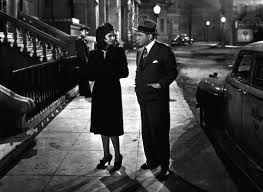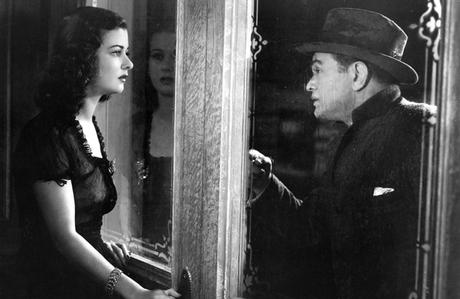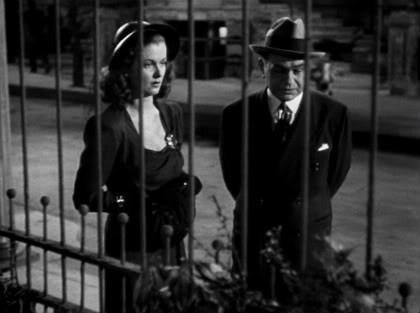Noirvember Review: 'The Woman in the Window'
 Every November fans of cinema celebrate one of the mediums most influential periods, the era of the film noir. This movement from the 1940's through the 1950's, presented audiences with edgy pulp crime flicks with a dark and moody stylization. Film noir gives moviegoers no shortage; troubled antiheroes, seductive femme fatales, grizzled detectives, ruthless villains, urban wastelands, and violent crimes. This month I will be looking at some of the best noirs for what has been dubbed Noirvember.
Every November fans of cinema celebrate one of the mediums most influential periods, the era of the film noir. This movement from the 1940's through the 1950's, presented audiences with edgy pulp crime flicks with a dark and moody stylization. Film noir gives moviegoers no shortage; troubled antiheroes, seductive femme fatales, grizzled detectives, ruthless villains, urban wastelands, and violent crimes. This month I will be looking at some of the best noirs for what has been dubbed Noirvember. Before becoming one of the many film workers exiled from Europe in the wake of Hitler's rise to power, Austrian-born Fritz Lang was one of the continent's most visionary filmmakers. From his science fiction epic of the silent era Metropolis to his haunting thriller M, Lang was years ahead of many of his peers. He made his way to Hollywood where he took his talents to the shadowy world of film noir which his directorial style like a glove with works like: Hangmen Also Die! and Clash by Night. Unfortunately, his temper and argumentative nature did not win him many friends among the higher-ups, so while his movies were always masterfully made he often butted heads with producers. Despite his temperament, Fritz Lang along with the likes of: John Huston, Robert Siodmak and Edward Dmytryk, would be among the pioneers of the genre. In 1944, he directed a film which has gone on to become a favorite of noiristas, despite an ending many find disappointing the Woman in the Window.

For respected university professor Richard Wanley, there is something captivating about the portrait of a woman displayed in the shop window which neighbors the club he frequents. As fate would have it, on a night when his family is out of town, he has the fortune of crossing paths with, Alice, the woman who is the subject of said painting. After a night of drinking and discussing art they return to her place, and are surprised by Alice's lover who inevitably picks a fight. During the scuffle, Wanley is forced to kill the man in self-defense but they both know if this gets to the police there will be a series of uncomfortable questions to answer. Needless to say Professor Wanley's wife would also have some strong opinions about him being discovered in the apartment of a beautiful young woman after a night of drinking. They reluctantly agree the best course of action is to hide the body in a forested area outside of town. Unfortunately, the murdered man is a prominent business figure so the discovery of his body begins to garner some unwanted attention turning up the heat on the two accomplices. Making the bad situation worse is the introduction of Heidt a smarmy conman who sees this as the perfect way to blackmail his way into as much money as he can squeeze out of the two. With increasingly little hope that there will be an outcome where he emerges unscathed, the academic ponders whether or not ending it all may be his only way out.....but there is a controversial twist.

The pacing Fritz Lang utilizes in the Woman in the Window is meticulous and deliberate, creating an increasing dread with each passing moment. This works out masterfully as many of the film's best moments are when we watch carefully with bated breath while Alice and Wanley are plotting something out, only for a some passerby or worse yet an oblivious cop to enter the scene and immediately give us a jolt of panic. Given that neither of these characters are exactly brilliant criminal masterminds, the tension is that much heavier because at any moment they could make a stupid mistake which would ruin everything. Despite a reputation of being difficult to work with, screenwriter Nunnally Johnson was adamant about wanting Lang to direct this film as he felt his sarcastic wit and Lang's dark fatalism would make for an interesting blend. Indeed, it does as Johnson's script makes the characters feel likable and relatable, and as Lang puts them through the ringer as their growing sense of hopelessness creates pit of your own stomach. The biggest point of contention between Lang and his screenwriter, also happens to be the film's most divisive element, the ending. The use of the "it was all a dream" plot device honestly feel like a backslap to the face. After spending all this time with Wanley and Alice as they try desperately to stay one step ahead, learning none of it actually happen is deflating. Audiences no doubt roll their eyes and assume it was slapped on as an appeasement to the Hollywood Code a frequent foe to makers of film noir. But behind the scenes, Nunnally Johnson was prepared to go to war against the Code in order to keep his bleak ending where Wanley opts to commit suicide when he feels he has finally reached his wit's end. Surprisingly it was Lang who made the final decision that ultimately Wanley was a good guy who made a bad choice in the heat of the moment and did not deserve such a fate.
One of the strongest aspects of this film is the performance from Edward G. Robinson as Professor Wanley. This was during a period of his career where he knew he had to transition away from the violent gangsters which made him a household name and into complex character actor roles. Films like this one along with Double Indemnity, the Ten Commandments and his later Lang collaboration Scarlett Street, provided that bridge in his career. Woman in the Window allowed audiences to see he was just as great at being a man who would spend his evenings in a lounge with fellow scholars, as he was mowing people down with a Tommy gun. As Alice the titular "Woman in the Window", Lang had to fight to get Joan Bennett cast in the role, and we are lucky he did. Her combination of beauty and screen presence make this femme fatale the ultimate siren who could lure the straight-laced intellectual into the mess the two become tied up in. Bennett finds the perfect balance between tenacious and vulnerable in her performance needed to make the audience captivated by her. Upon her death in 1990, the New York Times referred to Bennett as one of the most underrated actresses of all-time and with performances such as this film, cult favorite series Dark Shadows and the horror classic Suspiria it is hard to disagree. Completing the acting trifecta is notorious noir baddie, Dan Duryea as Heidt. Despite being a sociopath who makes audiences cringe, he brings a disarming boyish charm to the villain of the piece which makes him all the more dangerous.

While the quality of the ending will be endlessly debated in the Woman in the Window, the film is a fantastic tension filled thriller of a noir. For many Noiristas worth their weight in bullets and cigarettes this is a flick they hold a special appreciation for. I believe it is because it is a nice gateway to Fritz Lang's filmography as it is not as cynical as his work traditionally is. The fact that Edward G. Robinson also gives one of the best perfromances of his legendary career also can not hurt. Strangely enough Lang and the cast would reunite the following year for a similar film Scarlett Street which actually sticks to a far darker conclusion.

